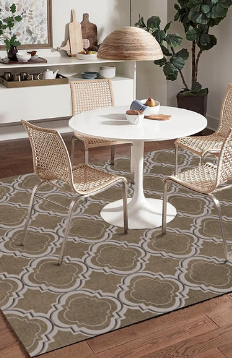When it comes to creating a comfortable and supportive indoor running environment, selecting the right material for your runner rug is essential. The material plays a significant role in determining the rug's durability, cushioning properties, grip, and overall performance. In this article, we will analyze different runner rug materials and provide insights to help you choose the most suitable surface for your workouts.
- Nylon: Nylon is a popular material choice for runner rugs due to its exceptional durability. It can withstand heavy foot traffic and is resistant to stains, making it ideal for high-intensity workouts. Nylon rugs offer excellent cushioning and support, reducing the impact on your joints during running. They are also easy to clean and maintain, making them a practical choice for active individuals.
- Polypropylene: Polypropylene, also known as olefin, is another commonly used material for runner rugs. It is highly resistant to moisture, making it suitable for areas prone to spills or humidity. Polypropylene rugs are lightweight, easy to clean, and have excellent colorfastness, ensuring their appearance remains vibrant over time. While they may not provide as much cushioning as other materials, they offer good durability and are budget-friendly.
- Polyester: Polyester Runner Rugs are known for their softness and luxurious feel. They offer moderate cushioning and are resistant to fading and staining. Polyester rugs are available in a wide range of colors and patterns, allowing you to add a touch of style to your workout space. However, they may not be as durable as nylon or polypropylene, especially in high-traffic areas.

- Wool: Wool runner rugs are highly regarded for their natural warmth and softness. They provide excellent cushioning and insulation, keeping your feet comfortable during workouts. Wool rugs are naturally flame-resistant, hypoallergenic, and have the ability to regulate humidity, creating a pleasant indoor environment. However, they require more maintenance compared to synthetic materials and may be more expensive.
- Natural Fiber (Sisal, Jute, Seagrass): Natural fiber runner rugs, such as sisal, jute, and seagrass, offer a unique and eco-friendly option. These rugs are made from renewable plant materials, making them a sustainable choice. They provide a textured surface and offer moderate cushioning. Natural fiber rugs are best suited for low-impact exercises and can add a touch of natural beauty to your workout area. However, they may not be as durable as synthetic materials and require extra care to prevent stains and water damage.
Conclusion: Choosing the right material for your runner rug is crucial to create the perfect surface for your workouts. Consider factors such as durability, cushioning, grip, and maintenance requirements when making your decision. Nylon offers excellent durability and support, while polypropylene is moisture-resistant and budget-friendly. Polyester provides softness and style options, and wool offers natural warmth and insulation. Natural fiber rugs are eco-friendly but may require extra care. Assess your specific needs and preferences to select the material that best suits your indoor running routine and enhances your overall workout experience.
Keywords: Runner Rugs, material analysis, nylon, polypropylene, polyester, wool, natural fiber, durability, cushioning, grip, maintenance.